Evaluation of the Macroeconomic Performance of Australia and USA
VerifiedAdded on 2023/06/12
|13
|3576
|482
AI Summary
This report evaluates the macroeconomic performance of Australia compared to that of USA. It analyzes the relationship between macroeconomic indicators, net export and exchange rate, cash rate of Australia and Federal Reserve rate of USA, and predicts the macroeconomic outlook of the Australian economy.
Contribute Materials
Your contribution can guide someone’s learning journey. Share your
documents today.
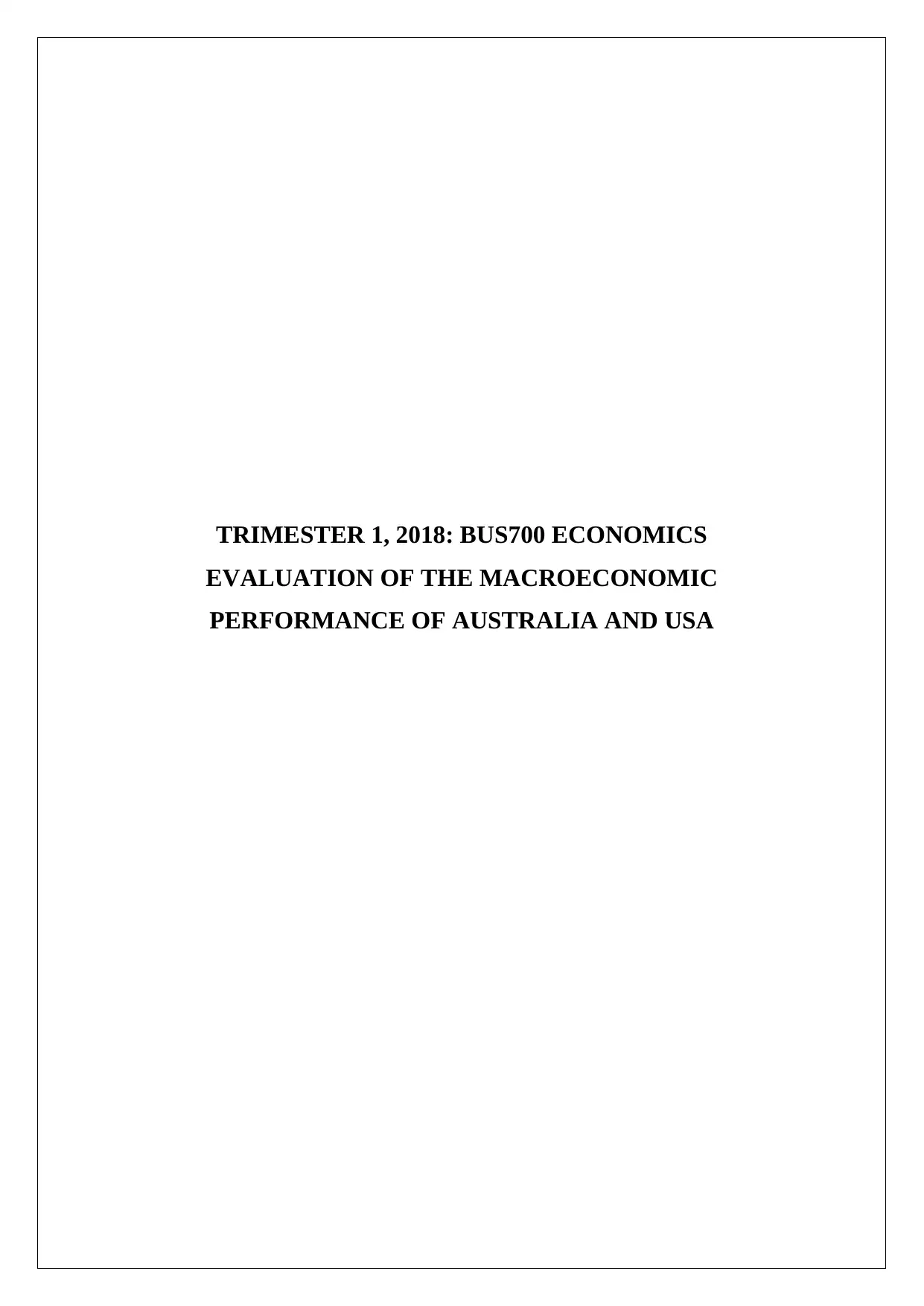
TRIMESTER 1, 2018: BUS700 ECONOMICS
EVALUATION OF THE MACROECONOMIC
PERFORMANCE OF AUSTRALIA AND USA
EVALUATION OF THE MACROECONOMIC
PERFORMANCE OF AUSTRALIA AND USA
Secure Best Marks with AI Grader
Need help grading? Try our AI Grader for instant feedback on your assignments.
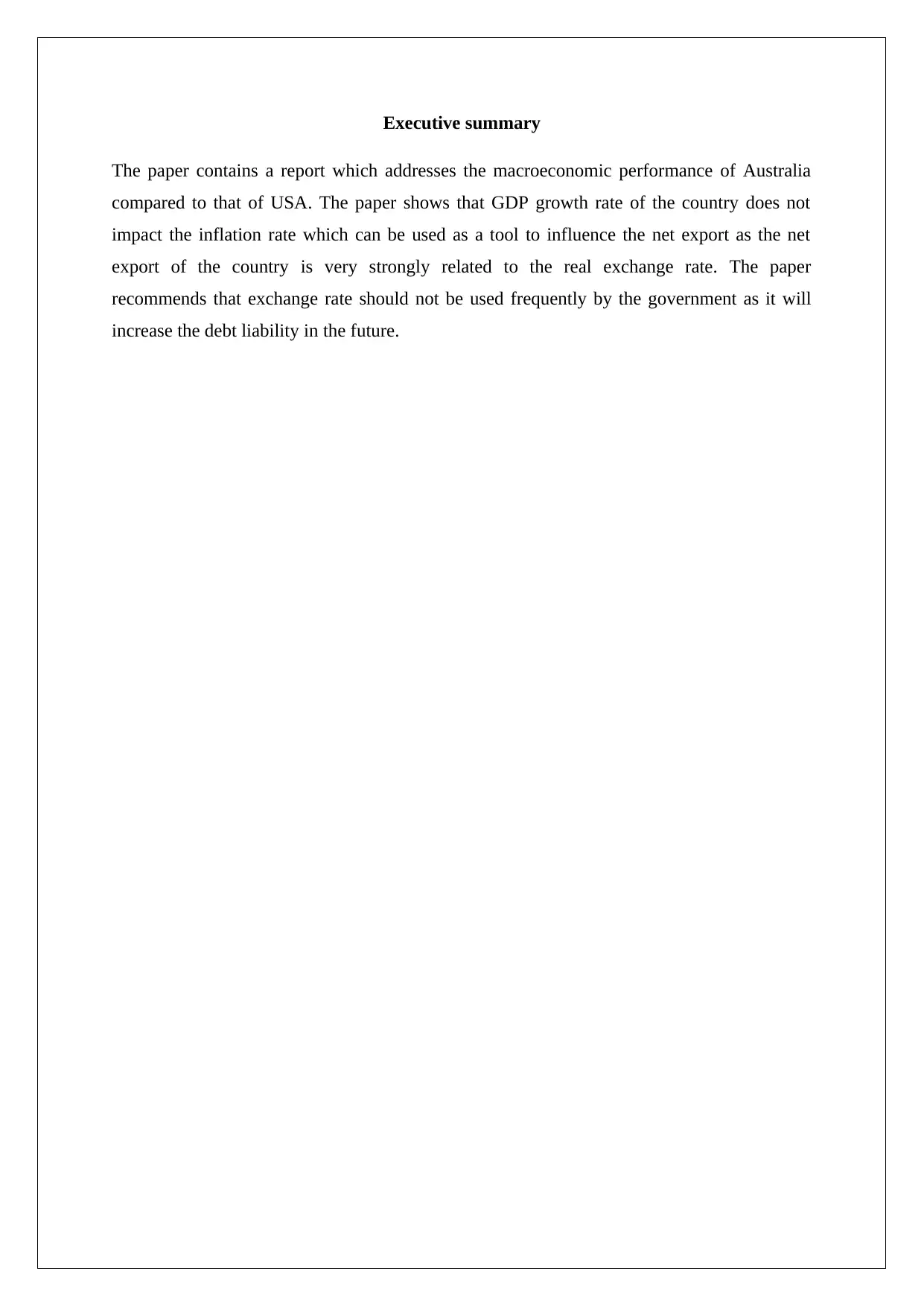
Executive summary
The paper contains a report which addresses the macroeconomic performance of Australia
compared to that of USA. The paper shows that GDP growth rate of the country does not
impact the inflation rate which can be used as a tool to influence the net export as the net
export of the country is very strongly related to the real exchange rate. The paper
recommends that exchange rate should not be used frequently by the government as it will
increase the debt liability in the future.
The paper contains a report which addresses the macroeconomic performance of Australia
compared to that of USA. The paper shows that GDP growth rate of the country does not
impact the inflation rate which can be used as a tool to influence the net export as the net
export of the country is very strongly related to the real exchange rate. The paper
recommends that exchange rate should not be used frequently by the government as it will
increase the debt liability in the future.
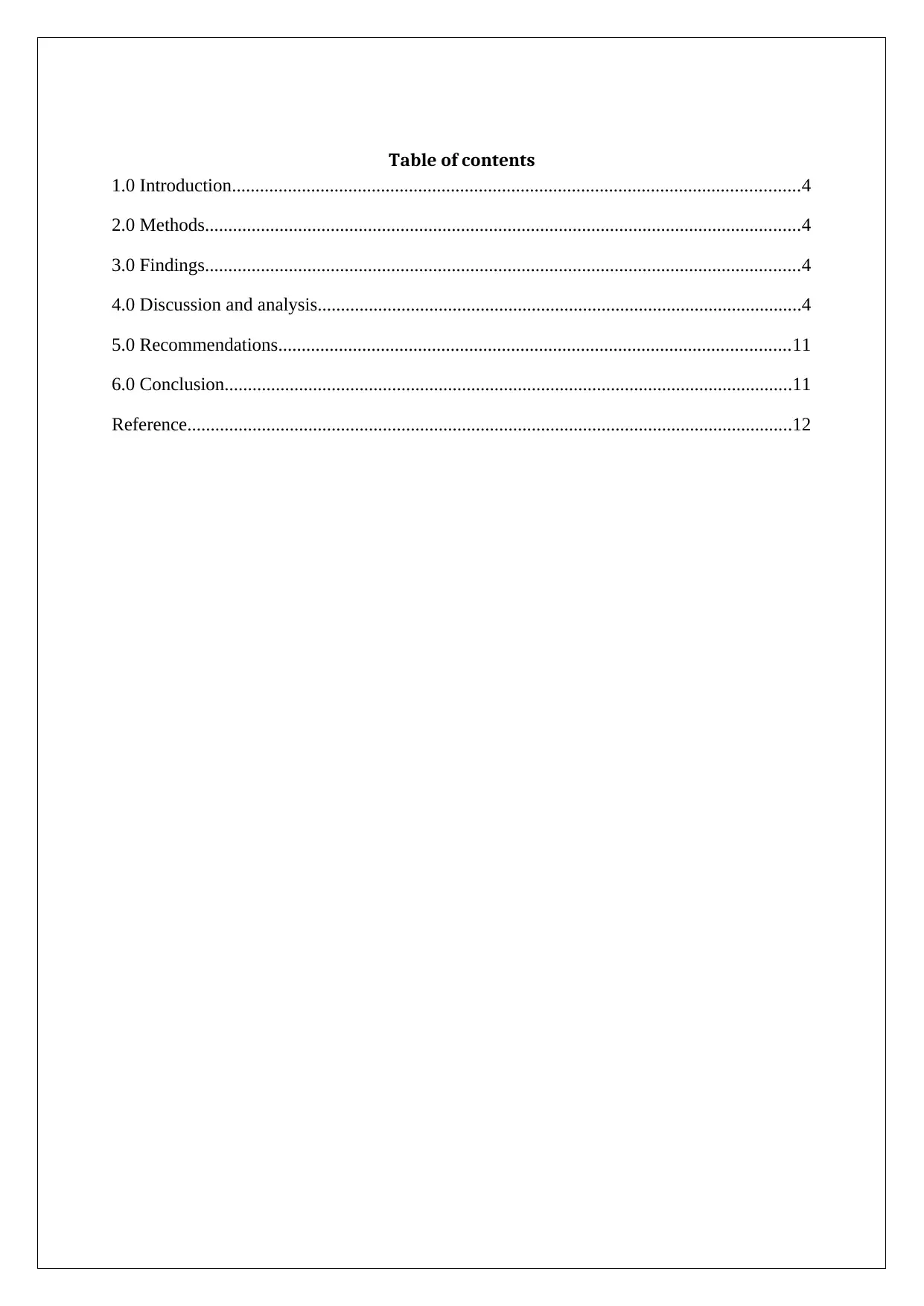
Table of contents
1.0 Introduction..........................................................................................................................4
2.0 Methods................................................................................................................................4
3.0 Findings................................................................................................................................4
4.0 Discussion and analysis........................................................................................................4
5.0 Recommendations..............................................................................................................11
6.0 Conclusion..........................................................................................................................11
Reference..................................................................................................................................12
1.0 Introduction..........................................................................................................................4
2.0 Methods................................................................................................................................4
3.0 Findings................................................................................................................................4
4.0 Discussion and analysis........................................................................................................4
5.0 Recommendations..............................................................................................................11
6.0 Conclusion..........................................................................................................................11
Reference..................................................................................................................................12
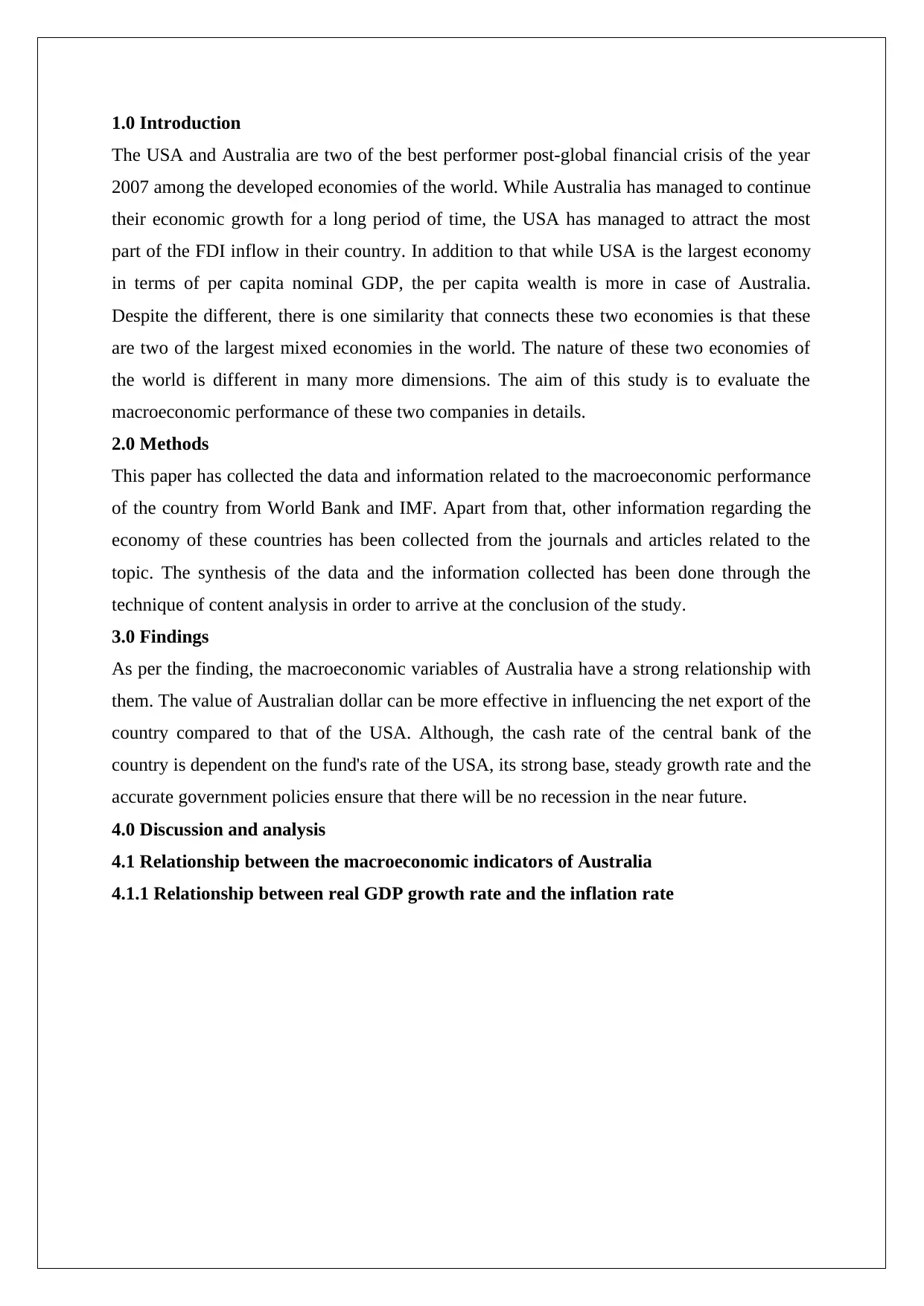
1.0 Introduction
The USA and Australia are two of the best performer post-global financial crisis of the year
2007 among the developed economies of the world. While Australia has managed to continue
their economic growth for a long period of time, the USA has managed to attract the most
part of the FDI inflow in their country. In addition to that while USA is the largest economy
in terms of per capita nominal GDP, the per capita wealth is more in case of Australia.
Despite the different, there is one similarity that connects these two economies is that these
are two of the largest mixed economies in the world. The nature of these two economies of
the world is different in many more dimensions. The aim of this study is to evaluate the
macroeconomic performance of these two companies in details.
2.0 Methods
This paper has collected the data and information related to the macroeconomic performance
of the country from World Bank and IMF. Apart from that, other information regarding the
economy of these countries has been collected from the journals and articles related to the
topic. The synthesis of the data and the information collected has been done through the
technique of content analysis in order to arrive at the conclusion of the study.
3.0 Findings
As per the finding, the macroeconomic variables of Australia have a strong relationship with
them. The value of Australian dollar can be more effective in influencing the net export of the
country compared to that of the USA. Although, the cash rate of the central bank of the
country is dependent on the fund's rate of the USA, its strong base, steady growth rate and the
accurate government policies ensure that there will be no recession in the near future.
4.0 Discussion and analysis
4.1 Relationship between the macroeconomic indicators of Australia
4.1.1 Relationship between real GDP growth rate and the inflation rate
The USA and Australia are two of the best performer post-global financial crisis of the year
2007 among the developed economies of the world. While Australia has managed to continue
their economic growth for a long period of time, the USA has managed to attract the most
part of the FDI inflow in their country. In addition to that while USA is the largest economy
in terms of per capita nominal GDP, the per capita wealth is more in case of Australia.
Despite the different, there is one similarity that connects these two economies is that these
are two of the largest mixed economies in the world. The nature of these two economies of
the world is different in many more dimensions. The aim of this study is to evaluate the
macroeconomic performance of these two companies in details.
2.0 Methods
This paper has collected the data and information related to the macroeconomic performance
of the country from World Bank and IMF. Apart from that, other information regarding the
economy of these countries has been collected from the journals and articles related to the
topic. The synthesis of the data and the information collected has been done through the
technique of content analysis in order to arrive at the conclusion of the study.
3.0 Findings
As per the finding, the macroeconomic variables of Australia have a strong relationship with
them. The value of Australian dollar can be more effective in influencing the net export of the
country compared to that of the USA. Although, the cash rate of the central bank of the
country is dependent on the fund's rate of the USA, its strong base, steady growth rate and the
accurate government policies ensure that there will be no recession in the near future.
4.0 Discussion and analysis
4.1 Relationship between the macroeconomic indicators of Australia
4.1.1 Relationship between real GDP growth rate and the inflation rate
Secure Best Marks with AI Grader
Need help grading? Try our AI Grader for instant feedback on your assignments.
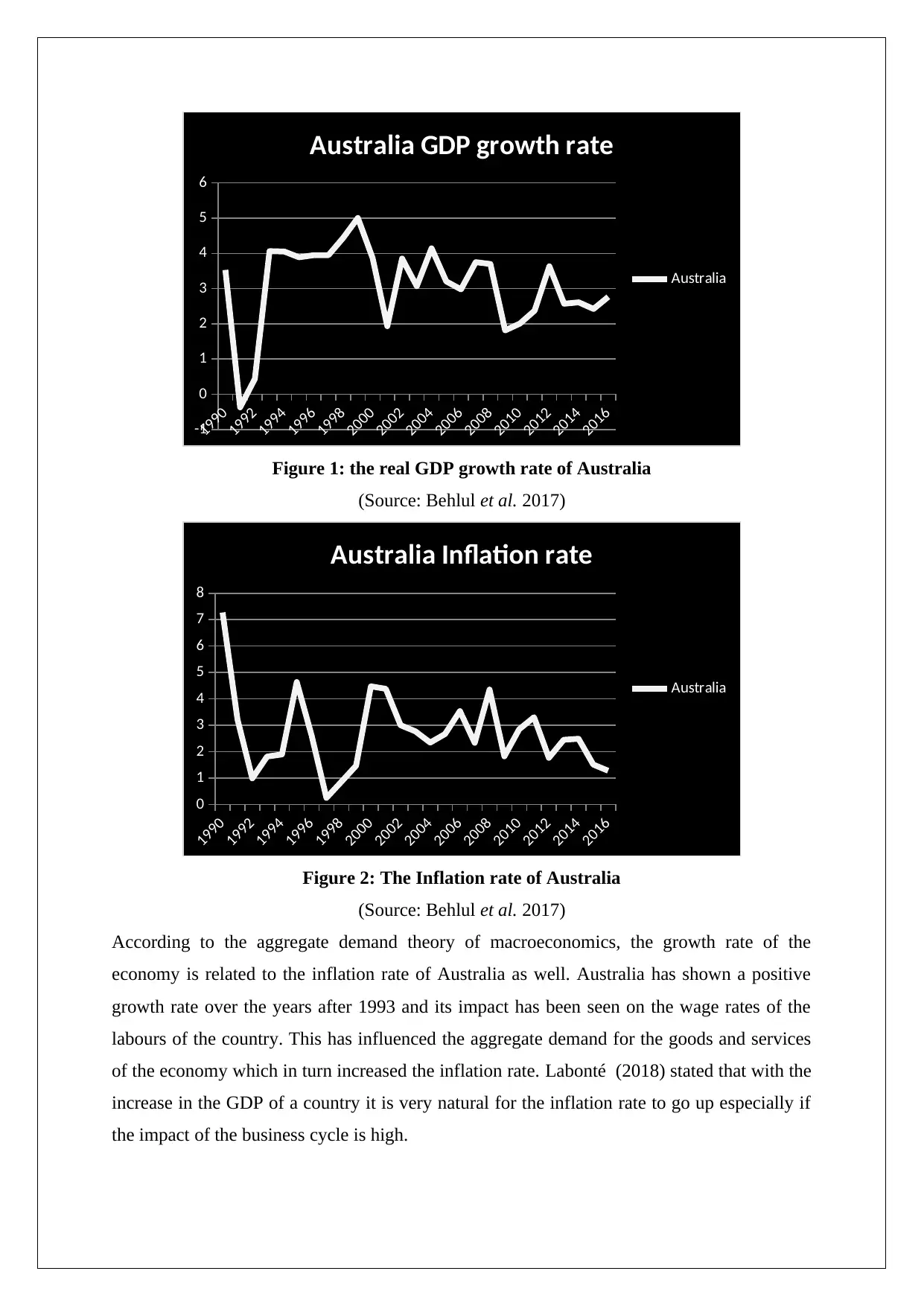
1990
1992
1994
1996
1998
2000
2002
2004
2006
2008
2010
2012
2014
2016
-1
0
1
2
3
4
5
6
Australia GDP growth rate
Australia
Figure 1: the real GDP growth rate of Australia
(Source: Behlul et al. 2017)
1990
1992
1994
1996
1998
2000
2002
2004
2006
2008
2010
2012
2014
2016
0
1
2
3
4
5
6
7
8
Australia Inflation rate
Australia
Figure 2: The Inflation rate of Australia
(Source: Behlul et al. 2017)
According to the aggregate demand theory of macroeconomics, the growth rate of the
economy is related to the inflation rate of Australia as well. Australia has shown a positive
growth rate over the years after 1993 and its impact has been seen on the wage rates of the
labours of the country. This has influenced the aggregate demand for the goods and services
of the economy which in turn increased the inflation rate. Labonté (2018) stated that with the
increase in the GDP of a country it is very natural for the inflation rate to go up especially if
the impact of the business cycle is high.
1992
1994
1996
1998
2000
2002
2004
2006
2008
2010
2012
2014
2016
-1
0
1
2
3
4
5
6
Australia GDP growth rate
Australia
Figure 1: the real GDP growth rate of Australia
(Source: Behlul et al. 2017)
1990
1992
1994
1996
1998
2000
2002
2004
2006
2008
2010
2012
2014
2016
0
1
2
3
4
5
6
7
8
Australia Inflation rate
Australia
Figure 2: The Inflation rate of Australia
(Source: Behlul et al. 2017)
According to the aggregate demand theory of macroeconomics, the growth rate of the
economy is related to the inflation rate of Australia as well. Australia has shown a positive
growth rate over the years after 1993 and its impact has been seen on the wage rates of the
labours of the country. This has influenced the aggregate demand for the goods and services
of the economy which in turn increased the inflation rate. Labonté (2018) stated that with the
increase in the GDP of a country it is very natural for the inflation rate to go up especially if
the impact of the business cycle is high.
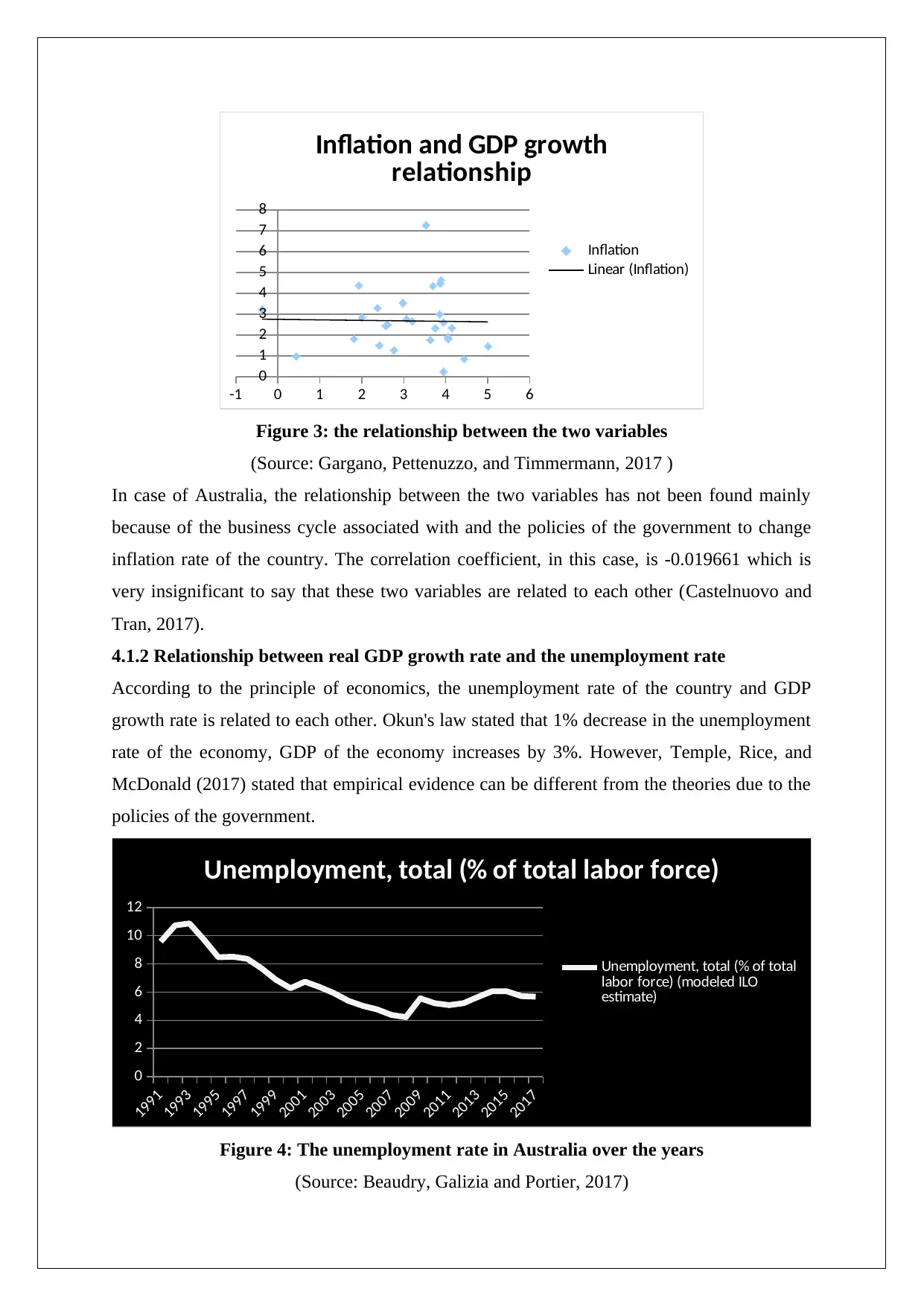
-1 0 1 2 3 4 5 6
0
1
2
3
4
5
6
7
8
Inflation and GDP growth
relationship
Inflation
Linear (Inflation)
Figure 3: the relationship between the two variables
(Source: Gargano, Pettenuzzo, and Timmermann, 2017 )
In case of Australia, the relationship between the two variables has not been found mainly
because of the business cycle associated with and the policies of the government to change
inflation rate of the country. The correlation coefficient, in this case, is -0.019661 which is
very insignificant to say that these two variables are related to each other (Castelnuovo and
Tran, 2017).
4.1.2 Relationship between real GDP growth rate and the unemployment rate
According to the principle of economics, the unemployment rate of the country and GDP
growth rate is related to each other. Okun's law stated that 1% decrease in the unemployment
rate of the economy, GDP of the economy increases by 3%. However, Temple, Rice, and
McDonald (2017) stated that empirical evidence can be different from the theories due to the
policies of the government.
1991
1993
1995
1997
1999
2001
2003
2005
2007
2009
2011
2013
2015
2017
0
2
4
6
8
10
12
Unemployment, total (% of total labor force)
Unemployment, total (% of total
labor force) (modeled ILO
estimate)
Figure 4: The unemployment rate in Australia over the years
(Source: Beaudry, Galizia and Portier, 2017)
0
1
2
3
4
5
6
7
8
Inflation and GDP growth
relationship
Inflation
Linear (Inflation)
Figure 3: the relationship between the two variables
(Source: Gargano, Pettenuzzo, and Timmermann, 2017 )
In case of Australia, the relationship between the two variables has not been found mainly
because of the business cycle associated with and the policies of the government to change
inflation rate of the country. The correlation coefficient, in this case, is -0.019661 which is
very insignificant to say that these two variables are related to each other (Castelnuovo and
Tran, 2017).
4.1.2 Relationship between real GDP growth rate and the unemployment rate
According to the principle of economics, the unemployment rate of the country and GDP
growth rate is related to each other. Okun's law stated that 1% decrease in the unemployment
rate of the economy, GDP of the economy increases by 3%. However, Temple, Rice, and
McDonald (2017) stated that empirical evidence can be different from the theories due to the
policies of the government.
1991
1993
1995
1997
1999
2001
2003
2005
2007
2009
2011
2013
2015
2017
0
2
4
6
8
10
12
Unemployment, total (% of total labor force)
Unemployment, total (% of total
labor force) (modeled ILO
estimate)
Figure 4: The unemployment rate in Australia over the years
(Source: Beaudry, Galizia and Portier, 2017)

In the case of Australia, the unemployment rate has reduced since the level of 1991. The
unemployment rate mainly reduced during the years 2003 to 2007 due to the mining boom
that it experienced. However, post global financial crisis has increased the unemployment
rate of the economy. The unemployment rate of the economy of Australia is related to the
GDP growth rate of the country (Tian et al. 2017). The correlation coefficient between the
variables is -0.241289. This means there exists a moderate negative relationship between the
variables. However, it deviates a little from the theoretical level due to the fact that, the
business cycle has worked and the policies of the government. The policies of the
government in case of Australia have been directed to smooth the indicators such as the
unemployment and inflation.
4.2 Discussion of the relationship between the net export and exchange rate for USA
and Australia
The net export of a country is the total volume of export minus the import. The next export of
any country is dependent on the value of the currency or the exchange rate (Blyth and
Matthijs, 2017). When the value of the domestic currency increases it is beneficial for the
importer and vice versa.
60 70 80 90 100 110 120
-250
-200
-150
-100
-50
0
50
Relationship between net export
and real exchange rate (Australia)
Australia
Linear (Australia)
Figure 5: The relationship between the net export and exchange rate in case of Australia
(Source: Chidozie and Ayadi, 2017)
The trend line in the above figure shows that the next export falls with the increase in the
exchange rate. Apart from that the correlation coefficient which in this case is -0.962197 also
suggests that the relationship between the variables is very strong and negative. This is due to
the facts the reduction in the exchange rate reduces the import and hence increases the net
export.
unemployment rate mainly reduced during the years 2003 to 2007 due to the mining boom
that it experienced. However, post global financial crisis has increased the unemployment
rate of the economy. The unemployment rate of the economy of Australia is related to the
GDP growth rate of the country (Tian et al. 2017). The correlation coefficient between the
variables is -0.241289. This means there exists a moderate negative relationship between the
variables. However, it deviates a little from the theoretical level due to the fact that, the
business cycle has worked and the policies of the government. The policies of the
government in case of Australia have been directed to smooth the indicators such as the
unemployment and inflation.
4.2 Discussion of the relationship between the net export and exchange rate for USA
and Australia
The net export of a country is the total volume of export minus the import. The next export of
any country is dependent on the value of the currency or the exchange rate (Blyth and
Matthijs, 2017). When the value of the domestic currency increases it is beneficial for the
importer and vice versa.
60 70 80 90 100 110 120
-250
-200
-150
-100
-50
0
50
Relationship between net export
and real exchange rate (Australia)
Australia
Linear (Australia)
Figure 5: The relationship between the net export and exchange rate in case of Australia
(Source: Chidozie and Ayadi, 2017)
The trend line in the above figure shows that the next export falls with the increase in the
exchange rate. Apart from that the correlation coefficient which in this case is -0.962197 also
suggests that the relationship between the variables is very strong and negative. This is due to
the facts the reduction in the exchange rate reduces the import and hence increases the net
export.
Paraphrase This Document
Need a fresh take? Get an instant paraphrase of this document with our AI Paraphraser
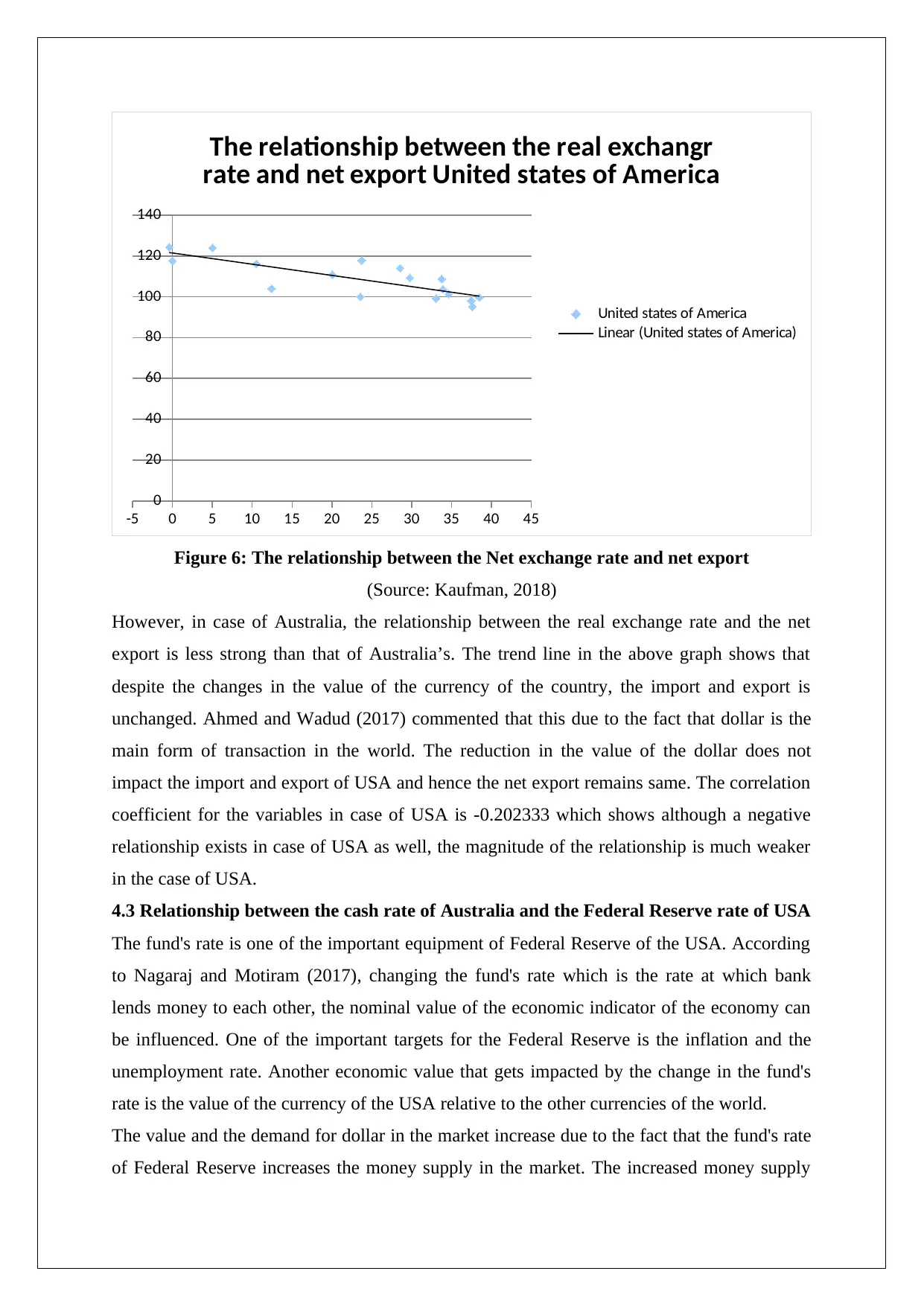
-5 0 5 10 15 20 25 30 35 40 45
0
20
40
60
80
100
120
140
The relationship between the real exchangr
rate and net export United states of America
United states of America
Linear (United states of America)
Figure 6: The relationship between the Net exchange rate and net export
(Source: Kaufman, 2018)
However, in case of Australia, the relationship between the real exchange rate and the net
export is less strong than that of Australia’s. The trend line in the above graph shows that
despite the changes in the value of the currency of the country, the import and export is
unchanged. Ahmed and Wadud (2017) commented that this due to the fact that dollar is the
main form of transaction in the world. The reduction in the value of the dollar does not
impact the import and export of USA and hence the net export remains same. The correlation
coefficient for the variables in case of USA is -0.202333 which shows although a negative
relationship exists in case of USA as well, the magnitude of the relationship is much weaker
in the case of USA.
4.3 Relationship between the cash rate of Australia and the Federal Reserve rate of USA
The fund's rate is one of the important equipment of Federal Reserve of the USA. According
to Nagaraj and Motiram (2017), changing the fund's rate which is the rate at which bank
lends money to each other, the nominal value of the economic indicator of the economy can
be influenced. One of the important targets for the Federal Reserve is the inflation and the
unemployment rate. Another economic value that gets impacted by the change in the fund's
rate is the value of the currency of the USA relative to the other currencies of the world.
The value and the demand for dollar in the market increase due to the fact that the fund's rate
of Federal Reserve increases the money supply in the market. The increased money supply
0
20
40
60
80
100
120
140
The relationship between the real exchangr
rate and net export United states of America
United states of America
Linear (United states of America)
Figure 6: The relationship between the Net exchange rate and net export
(Source: Kaufman, 2018)
However, in case of Australia, the relationship between the real exchange rate and the net
export is less strong than that of Australia’s. The trend line in the above graph shows that
despite the changes in the value of the currency of the country, the import and export is
unchanged. Ahmed and Wadud (2017) commented that this due to the fact that dollar is the
main form of transaction in the world. The reduction in the value of the dollar does not
impact the import and export of USA and hence the net export remains same. The correlation
coefficient for the variables in case of USA is -0.202333 which shows although a negative
relationship exists in case of USA as well, the magnitude of the relationship is much weaker
in the case of USA.
4.3 Relationship between the cash rate of Australia and the Federal Reserve rate of USA
The fund's rate is one of the important equipment of Federal Reserve of the USA. According
to Nagaraj and Motiram (2017), changing the fund's rate which is the rate at which bank
lends money to each other, the nominal value of the economic indicator of the economy can
be influenced. One of the important targets for the Federal Reserve is the inflation and the
unemployment rate. Another economic value that gets impacted by the change in the fund's
rate is the value of the currency of the USA relative to the other currencies of the world.
The value and the demand for dollar in the market increase due to the fact that the fund's rate
of Federal Reserve increases the money supply in the market. The increased money supply

also results in more transaction. According to the quantity theory of money, when the money
supply and the number of transaction in the market increase, the production and the prices of
the goods and services in the market are bound to increase (Nong, Meng and Siriwardana,
2017). Thus, the immediate impact of the change in the fund's rate of the USA is the inflation
in the market. This is also associated with high demand for the domestic products and hence
the value of the dollar increases in the market.
Given that the value of the dollar in the exchange market is very important for other countries
of the world as the dollar is the international currency, the value of the other currency also
changes. With the increase in the value of the dollar the value of Australian dollar falls and
hence the government changes the cash rates in order to maintain a steady value for the
currency (Foerster et al. 2017). However, the process used by the company in order to
change the value of the Australian currency is the cash rate. It is the rate at which the central
bank of Australia provides a loan to the commercial banks of the country. With the increase
in the cash rate the supply of money in the market will go down and hence, transaction
demand for money will increase giving a rise in the value of Australian dollar.
In the past, the central bank of Australia has used this policy a number of times in order to
deal with the changes in the fund's rate of the USA. Furlanetto and Robstad (2017) in this
context stated that, although this process is a good way to maintain the value of the
Australian currency and the net export of the market, it increases the inflation in the market.
According to the data, the inflation of Australia got impacted due to the changes in the cash
rate followed by the central bank of the country. Nevertheless, it is important for the central
bank of Australia to control the value of Australian dollar through the cash rates of banks as
this is the best and fast way to influence the demand for currency in the market (Berg, 2017).
4.4 Prediction for the macroeconomic outlook of the Australian economy
Based on Australian performance in terms of macroeconomic indicator, it can be said that the
current performance of the company and the policies of the government are going hand in
hand. In addition to that, the government also have taken the responsibility in order to
balance the economic indicators of the economy as well (Kishor and Marfatia, 2017). The
real exchange rate of Australia and its impacts on the net export clearly states that the
influence of business cycle is only minimal in case of Australia. Along with that the exchange
rate or the value of the Australian dollar has also been very strong in the last few years.
Now, given the mining boom that the economy of Australia just experienced, it is expected
that the economy of Australia will experience a boom in the near future (Taylor and Tyers,
2017). This is due to the fact that, the mining boom has increased the average wage rate of
supply and the number of transaction in the market increase, the production and the prices of
the goods and services in the market are bound to increase (Nong, Meng and Siriwardana,
2017). Thus, the immediate impact of the change in the fund's rate of the USA is the inflation
in the market. This is also associated with high demand for the domestic products and hence
the value of the dollar increases in the market.
Given that the value of the dollar in the exchange market is very important for other countries
of the world as the dollar is the international currency, the value of the other currency also
changes. With the increase in the value of the dollar the value of Australian dollar falls and
hence the government changes the cash rates in order to maintain a steady value for the
currency (Foerster et al. 2017). However, the process used by the company in order to
change the value of the Australian currency is the cash rate. It is the rate at which the central
bank of Australia provides a loan to the commercial banks of the country. With the increase
in the cash rate the supply of money in the market will go down and hence, transaction
demand for money will increase giving a rise in the value of Australian dollar.
In the past, the central bank of Australia has used this policy a number of times in order to
deal with the changes in the fund's rate of the USA. Furlanetto and Robstad (2017) in this
context stated that, although this process is a good way to maintain the value of the
Australian currency and the net export of the market, it increases the inflation in the market.
According to the data, the inflation of Australia got impacted due to the changes in the cash
rate followed by the central bank of the country. Nevertheless, it is important for the central
bank of Australia to control the value of Australian dollar through the cash rates of banks as
this is the best and fast way to influence the demand for currency in the market (Berg, 2017).
4.4 Prediction for the macroeconomic outlook of the Australian economy
Based on Australian performance in terms of macroeconomic indicator, it can be said that the
current performance of the company and the policies of the government are going hand in
hand. In addition to that, the government also have taken the responsibility in order to
balance the economic indicators of the economy as well (Kishor and Marfatia, 2017). The
real exchange rate of Australia and its impacts on the net export clearly states that the
influence of business cycle is only minimal in case of Australia. Along with that the exchange
rate or the value of the Australian dollar has also been very strong in the last few years.
Now, given the mining boom that the economy of Australia just experienced, it is expected
that the economy of Australia will experience a boom in the near future (Taylor and Tyers,
2017). This is due to the fact that, the mining boom has increased the average wage rate of
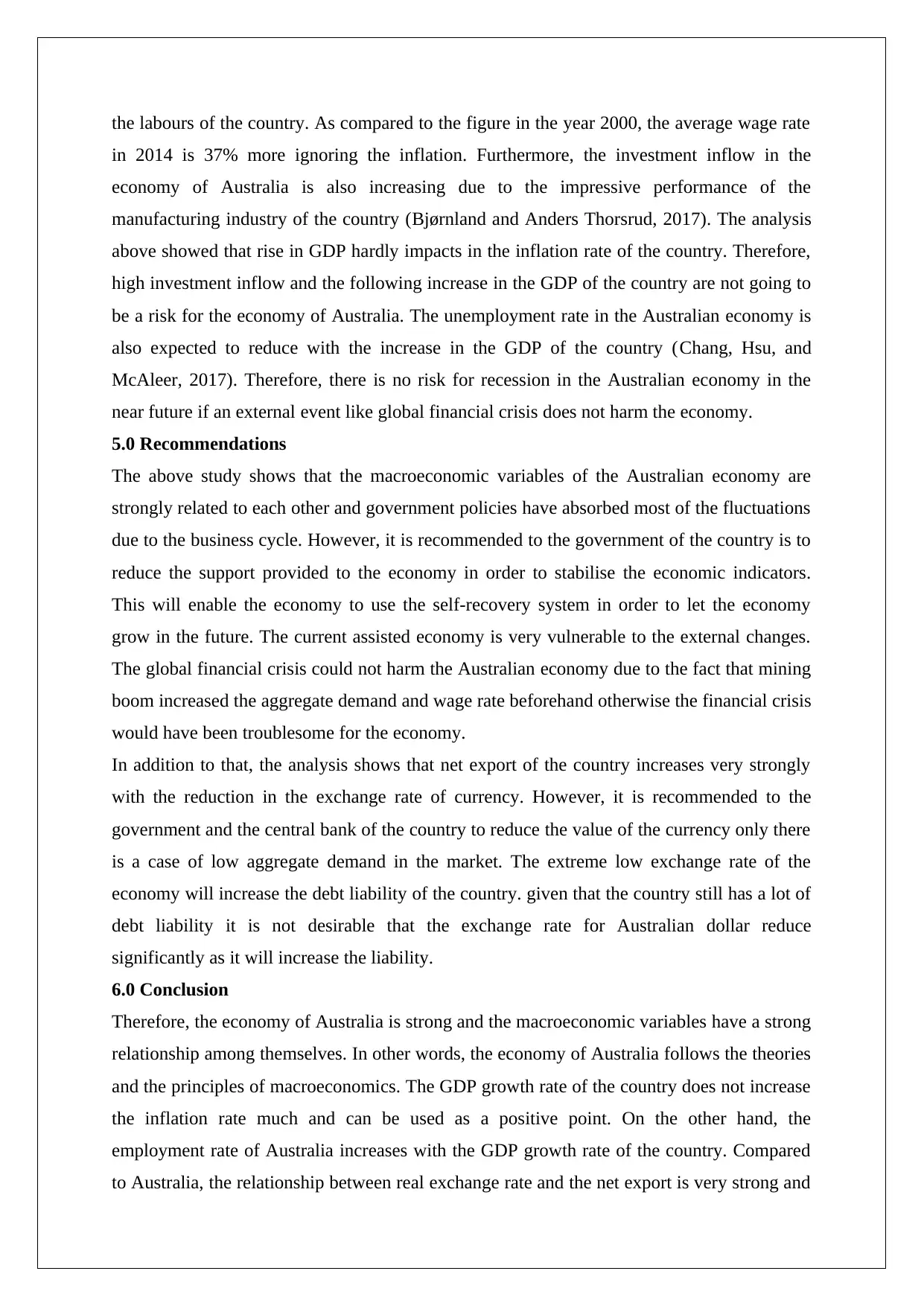
the labours of the country. As compared to the figure in the year 2000, the average wage rate
in 2014 is 37% more ignoring the inflation. Furthermore, the investment inflow in the
economy of Australia is also increasing due to the impressive performance of the
manufacturing industry of the country (Bjørnland and Anders Thorsrud, 2017). The analysis
above showed that rise in GDP hardly impacts in the inflation rate of the country. Therefore,
high investment inflow and the following increase in the GDP of the country are not going to
be a risk for the economy of Australia. The unemployment rate in the Australian economy is
also expected to reduce with the increase in the GDP of the country (Chang, Hsu, and
McAleer, 2017). Therefore, there is no risk for recession in the Australian economy in the
near future if an external event like global financial crisis does not harm the economy.
5.0 Recommendations
The above study shows that the macroeconomic variables of the Australian economy are
strongly related to each other and government policies have absorbed most of the fluctuations
due to the business cycle. However, it is recommended to the government of the country is to
reduce the support provided to the economy in order to stabilise the economic indicators.
This will enable the economy to use the self-recovery system in order to let the economy
grow in the future. The current assisted economy is very vulnerable to the external changes.
The global financial crisis could not harm the Australian economy due to the fact that mining
boom increased the aggregate demand and wage rate beforehand otherwise the financial crisis
would have been troublesome for the economy.
In addition to that, the analysis shows that net export of the country increases very strongly
with the reduction in the exchange rate of currency. However, it is recommended to the
government and the central bank of the country to reduce the value of the currency only there
is a case of low aggregate demand in the market. The extreme low exchange rate of the
economy will increase the debt liability of the country. given that the country still has a lot of
debt liability it is not desirable that the exchange rate for Australian dollar reduce
significantly as it will increase the liability.
6.0 Conclusion
Therefore, the economy of Australia is strong and the macroeconomic variables have a strong
relationship among themselves. In other words, the economy of Australia follows the theories
and the principles of macroeconomics. The GDP growth rate of the country does not increase
the inflation rate much and can be used as a positive point. On the other hand, the
employment rate of Australia increases with the GDP growth rate of the country. Compared
to Australia, the relationship between real exchange rate and the net export is very strong and
in 2014 is 37% more ignoring the inflation. Furthermore, the investment inflow in the
economy of Australia is also increasing due to the impressive performance of the
manufacturing industry of the country (Bjørnland and Anders Thorsrud, 2017). The analysis
above showed that rise in GDP hardly impacts in the inflation rate of the country. Therefore,
high investment inflow and the following increase in the GDP of the country are not going to
be a risk for the economy of Australia. The unemployment rate in the Australian economy is
also expected to reduce with the increase in the GDP of the country (Chang, Hsu, and
McAleer, 2017). Therefore, there is no risk for recession in the Australian economy in the
near future if an external event like global financial crisis does not harm the economy.
5.0 Recommendations
The above study shows that the macroeconomic variables of the Australian economy are
strongly related to each other and government policies have absorbed most of the fluctuations
due to the business cycle. However, it is recommended to the government of the country is to
reduce the support provided to the economy in order to stabilise the economic indicators.
This will enable the economy to use the self-recovery system in order to let the economy
grow in the future. The current assisted economy is very vulnerable to the external changes.
The global financial crisis could not harm the Australian economy due to the fact that mining
boom increased the aggregate demand and wage rate beforehand otherwise the financial crisis
would have been troublesome for the economy.
In addition to that, the analysis shows that net export of the country increases very strongly
with the reduction in the exchange rate of currency. However, it is recommended to the
government and the central bank of the country to reduce the value of the currency only there
is a case of low aggregate demand in the market. The extreme low exchange rate of the
economy will increase the debt liability of the country. given that the country still has a lot of
debt liability it is not desirable that the exchange rate for Australian dollar reduce
significantly as it will increase the liability.
6.0 Conclusion
Therefore, the economy of Australia is strong and the macroeconomic variables have a strong
relationship among themselves. In other words, the economy of Australia follows the theories
and the principles of macroeconomics. The GDP growth rate of the country does not increase
the inflation rate much and can be used as a positive point. On the other hand, the
employment rate of Australia increases with the GDP growth rate of the country. Compared
to Australia, the relationship between real exchange rate and the net export is very strong and
Secure Best Marks with AI Grader
Need help grading? Try our AI Grader for instant feedback on your assignments.
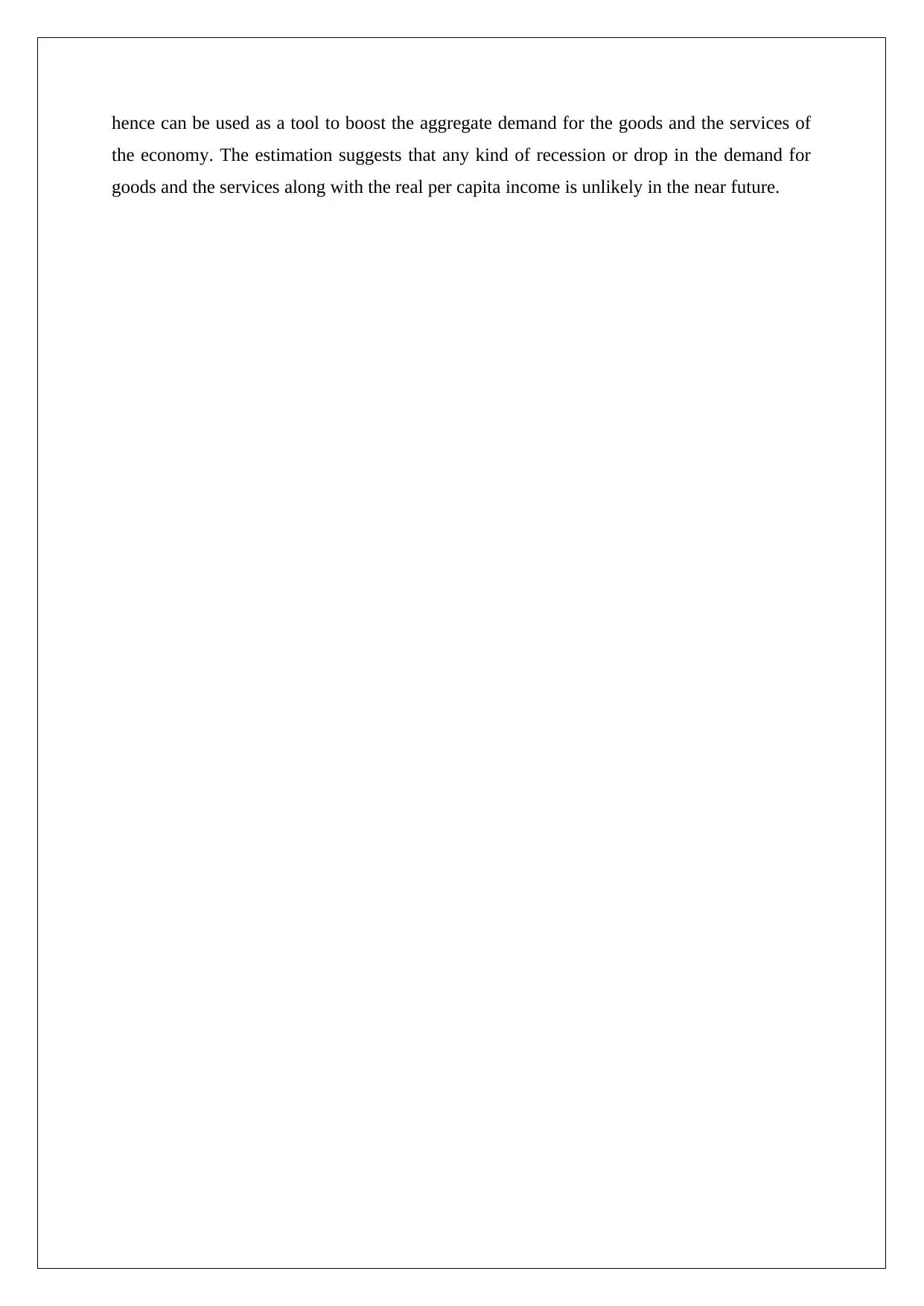
hence can be used as a tool to boost the aggregate demand for the goods and the services of
the economy. The estimation suggests that any kind of recession or drop in the demand for
goods and the services along with the real per capita income is unlikely in the near future.
the economy. The estimation suggests that any kind of recession or drop in the demand for
goods and the services along with the real per capita income is unlikely in the near future.

Reference
Ahmed, H.J.A. and Wadud, I.M., 2017. Oil Price Volatility And Sectoral Returns
Uncertainties: Evidence From A Threshold-Based Approach For The Australian Equity
Market. The Journal of Developing Areas, 51(1), pp.329-342.
Beaudry, P., Galizia, D. and Portier, F., 2017. Is the Macroeconomy Locally Unstable and
Why Should We Care?. NBER Macroeconomics Annual, 31(1), pp.479-530.
Behlul, T., Panagiotelis, A., Athanasopoulos, G., Hyndman, R.J. and Vahid, F., 2017. The
Australian Macro Database: An online resource for macroeconomic research in Australia.
Berg, C., 2017. Regulation and red tape in a small open economy: an Australian overview.
Bjørnland, H.C. and Anders Thorsrud, L., 2017. The ‘Dutch disease’reexamined: Resource
booms can benefit the wider economy. LSE Business Review.
Blyth, M. and Matthijs, M., 2017. Black Swans, Lame Ducks, and the mystery of IPE's
missing macroeconomy. Review of International Political Economy, 24(2), pp.203-231
Castelnuovo, E. and Tran, T.D., 2017. Google It Up! A Google Trends-based Uncertainty
Index for the United States and Australia. Economics Letters, 161, pp.149-153.
Chang, C.L., Hsu, H.K. and McAleer, M., 2017. A Tourism Financial Conditions Index for
Tourism Finance. Challenges, 8(2), p.23.
Chidozie, U.E. and Ayadi, F.S., 2017. Macroeconomy and Banks’ Profitability in
Nigeria. African Research Review, 11(2), pp.121-137.
Foerster, A.C., Peel, J., Osofsky, H.M. and McDonnell, B., 2017. Keeping Good Company in
the Transition to a Low Carbon Economy? An Evaluation of Climate Risk Disclosure
Practices in Australia.
Furlanetto, F. and Robstad, Ø., 2017. Immigration and the macroeconomy: Some new
empirical evidence.
Gargano, A., Pettenuzzo, D. and Timmermann, A., 2017. Bond return predictability:
Economic value and links to the macroeconomy. Management Science.
Ahmed, H.J.A. and Wadud, I.M., 2017. Oil Price Volatility And Sectoral Returns
Uncertainties: Evidence From A Threshold-Based Approach For The Australian Equity
Market. The Journal of Developing Areas, 51(1), pp.329-342.
Beaudry, P., Galizia, D. and Portier, F., 2017. Is the Macroeconomy Locally Unstable and
Why Should We Care?. NBER Macroeconomics Annual, 31(1), pp.479-530.
Behlul, T., Panagiotelis, A., Athanasopoulos, G., Hyndman, R.J. and Vahid, F., 2017. The
Australian Macro Database: An online resource for macroeconomic research in Australia.
Berg, C., 2017. Regulation and red tape in a small open economy: an Australian overview.
Bjørnland, H.C. and Anders Thorsrud, L., 2017. The ‘Dutch disease’reexamined: Resource
booms can benefit the wider economy. LSE Business Review.
Blyth, M. and Matthijs, M., 2017. Black Swans, Lame Ducks, and the mystery of IPE's
missing macroeconomy. Review of International Political Economy, 24(2), pp.203-231
Castelnuovo, E. and Tran, T.D., 2017. Google It Up! A Google Trends-based Uncertainty
Index for the United States and Australia. Economics Letters, 161, pp.149-153.
Chang, C.L., Hsu, H.K. and McAleer, M., 2017. A Tourism Financial Conditions Index for
Tourism Finance. Challenges, 8(2), p.23.
Chidozie, U.E. and Ayadi, F.S., 2017. Macroeconomy and Banks’ Profitability in
Nigeria. African Research Review, 11(2), pp.121-137.
Foerster, A.C., Peel, J., Osofsky, H.M. and McDonnell, B., 2017. Keeping Good Company in
the Transition to a Low Carbon Economy? An Evaluation of Climate Risk Disclosure
Practices in Australia.
Furlanetto, F. and Robstad, Ø., 2017. Immigration and the macroeconomy: Some new
empirical evidence.
Gargano, A., Pettenuzzo, D. and Timmermann, A., 2017. Bond return predictability:
Economic value and links to the macroeconomy. Management Science.

Kaufman, B.E., 2018. How Capitalism Endogenously Creates Rising Income Inequality and
Economic Crisis: The Macro Political Economy Model of Early Industrial
Relations. Industrial Relations: A Journal of Economy and Society, 57(1), pp.131-173.
Kishor, N.K. and Marfatia, H.A., 2017. The dynamic relationship between housing prices and
the macroeconomy: Evidence from OECD countries. The Journal of Real Estate Finance and
Economics, 54(2), pp.237-268.
Labonté, R., 2018. From mid-level policy analysis to the macro-level political economy:
Comment on "Developing a framework for a program theory-based approach to evaluating
policy processes and outcomes: Health in All Policies in South Australia.". Int J Health
Policy Manag.
Nagaraj, R. and Motiram, S. eds., 2017. Political Economy of Contemporary India.
Cambridge University Press.
Nong, D., Meng, S. and Siriwardana, M., 2017. An assessment of a proposed ETS in
Australia by using the MONASH-Green model. Energy Policy, 108, pp.281-291.
Taylor, G. and Tyers, R., 2017. Secular stagnation: Determinants and consequences for
Australia. Economic Record, 93(303), pp.615-650.
Temple, J.B., Rice, J.M. and McDonald, P.F., 2017. Ageing and the economic life cycle: The
National Transfer Accounts approach. Australasian Journal on ageing, 36(4), pp.271-278.
Tian, X., Dai, H., Geng, Y., Huang, Z., Masui, T. and Fujita, T., 2017. The effects of carbon
reduction on sectoral competitiveness in China: A case of Shanghai. Applied Energy, 197,
pp.270-278.
Economic Crisis: The Macro Political Economy Model of Early Industrial
Relations. Industrial Relations: A Journal of Economy and Society, 57(1), pp.131-173.
Kishor, N.K. and Marfatia, H.A., 2017. The dynamic relationship between housing prices and
the macroeconomy: Evidence from OECD countries. The Journal of Real Estate Finance and
Economics, 54(2), pp.237-268.
Labonté, R., 2018. From mid-level policy analysis to the macro-level political economy:
Comment on "Developing a framework for a program theory-based approach to evaluating
policy processes and outcomes: Health in All Policies in South Australia.". Int J Health
Policy Manag.
Nagaraj, R. and Motiram, S. eds., 2017. Political Economy of Contemporary India.
Cambridge University Press.
Nong, D., Meng, S. and Siriwardana, M., 2017. An assessment of a proposed ETS in
Australia by using the MONASH-Green model. Energy Policy, 108, pp.281-291.
Taylor, G. and Tyers, R., 2017. Secular stagnation: Determinants and consequences for
Australia. Economic Record, 93(303), pp.615-650.
Temple, J.B., Rice, J.M. and McDonald, P.F., 2017. Ageing and the economic life cycle: The
National Transfer Accounts approach. Australasian Journal on ageing, 36(4), pp.271-278.
Tian, X., Dai, H., Geng, Y., Huang, Z., Masui, T. and Fujita, T., 2017. The effects of carbon
reduction on sectoral competitiveness in China: A case of Shanghai. Applied Energy, 197,
pp.270-278.
1 out of 13
Related Documents
Your All-in-One AI-Powered Toolkit for Academic Success.
+13062052269
info@desklib.com
Available 24*7 on WhatsApp / Email
![[object Object]](/_next/static/media/star-bottom.7253800d.svg)
Unlock your academic potential
© 2024 | Zucol Services PVT LTD | All rights reserved.





